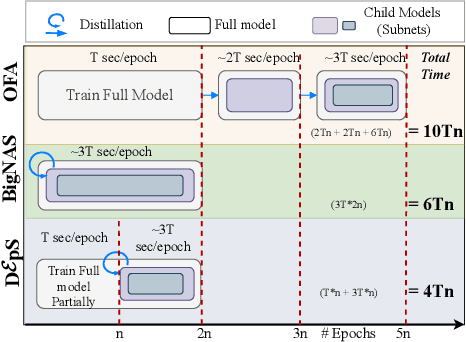Aditya Annavajjala
DεpS: Delayed ε-Shrinking for Faster Once-For-All Training
Jul 08, 2024



Abstract:CNNs are increasingly deployed across different hardware, dynamic environments, and low-power embedded devices. This has led to the design and training of CNN architectures with the goal of maximizing accuracy subject to such variable deployment constraints. As the number of deployment scenarios grows, there is a need to find scalable solutions to design and train specialized CNNs. Once-for-all training has emerged as a scalable approach that jointly co-trains many models (subnets) at once with a constant training cost and finds specialized CNNs later. The scalability is achieved by training the full model and simultaneously reducing it to smaller subnets that share model weights (weight-shared shrinking). However, existing once-for-all training approaches incur huge training costs reaching 1200 GPU hours. We argue this is because they either start the process of shrinking the full model too early or too late. Hence, we propose Delayed $\epsilon$-Shrinking (D$\epsilon$pS) that starts the process of shrinking the full model when it is partially trained (~50%) which leads to training cost improvement and better in-place knowledge distillation to smaller models. The proposed approach also consists of novel heuristics that dynamically adjust subnet learning rates incrementally (E), leading to improved weight-shared knowledge distillation from larger to smaller subnets as well. As a result, DEpS outperforms state-of-the-art once-for-all training techniques across different datasets including CIFAR10/100, ImageNet-100, and ImageNet-1k on accuracy and cost. It achieves 1.83% higher ImageNet-1k top1 accuracy or the same accuracy with 1.3x reduction in FLOPs and 2.5x drop in training cost (GPU*hrs)
NurtureNet: A Multi-task Video-based Approach for Newborn Anthropometry
May 09, 2024Abstract:Malnutrition among newborns is a top public health concern in developing countries. Identification and subsequent growth monitoring are key to successful interventions. However, this is challenging in rural communities where health systems tend to be inaccessible and under-equipped, with poor adherence to protocol. Our goal is to equip health workers and public health systems with a solution for contactless newborn anthropometry in the community. We propose NurtureNet, a multi-task model that fuses visual information (a video taken with a low-cost smartphone) with tabular inputs to regress multiple anthropometry estimates including weight, length, head circumference, and chest circumference. We show that visual proxy tasks of segmentation and keypoint prediction further improve performance. We establish the efficacy of the model through several experiments and achieve a relative error of 3.9% and mean absolute error of 114.3 g for weight estimation. Model compression to 15 MB also allows offline deployment to low-cost smartphones.
 Add to Chrome
Add to Chrome Add to Firefox
Add to Firefox Add to Edge
Add to Edge